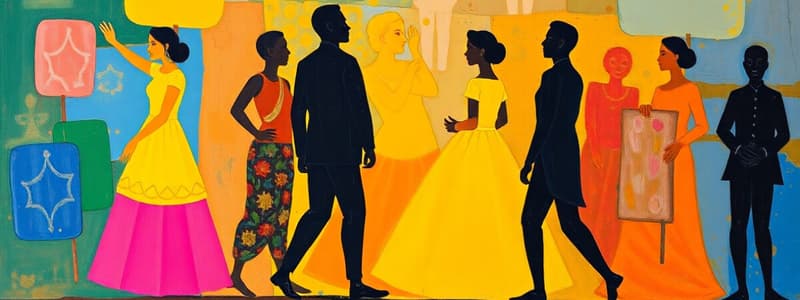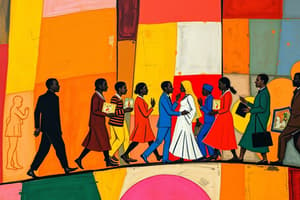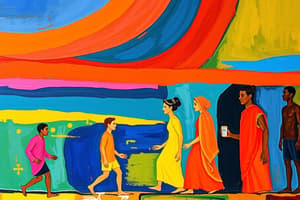Podcast
Questions and Answers
What characterizes the response of 'Innovators' in Merton's Strain Theory?
What characterizes the response of 'Innovators' in Merton's Strain Theory?
- They accept both societal goals and the means to achieve them.
- They create new means to achieve societal goals. (correct)
- They completely reject societal goals.
- They withdraw from societal expectations.
Which concept refers to the discrediting societal labels can impose on individuals?
Which concept refers to the discrediting societal labels can impose on individuals?
- Secondary Deviance
- Retreatism
- Stigma (correct)
- Primary Deviance
How does Bruce Western's research contribute to discussions on deviance?
How does Bruce Western's research contribute to discussions on deviance?
- It suggests that laws equally criminalize all demographics.
- It supports the notion that punishment deters all deviant behavior.
- It promotes the idea that deviance is purely a personal choice.
- It highlights systemic inequalities in incarceration rates. (correct)
Which response to deviance is focused on reforming offenders rather than punishing them?
Which response to deviance is focused on reforming offenders rather than punishing them?
What differentiates 'Occupational Crime' from 'Organizational Crime'?
What differentiates 'Occupational Crime' from 'Organizational Crime'?
What does social stratification primarily reflect?
What does social stratification primarily reflect?
Which term refers to the ability to move within the social hierarchy?
Which term refers to the ability to move within the social hierarchy?
Which system is characterized by a rigid social hierarchy based on ascription?
Which system is characterized by a rigid social hierarchy based on ascription?
What distinguishes the class system from the caste system?
What distinguishes the class system from the caste system?
Which concept describes the belief that success is achieved through individual effort and talent?
Which concept describes the belief that success is achieved through individual effort and talent?
Which type of poverty is characterized by severe deprivation of basic human needs?
Which type of poverty is characterized by severe deprivation of basic human needs?
Which of the following is included in Pierre Bourdieu’s types of capital?
Which of the following is included in Pierre Bourdieu’s types of capital?
Max Weber emphasized which additional dimensions of social stratification besides class?
Max Weber emphasized which additional dimensions of social stratification besides class?
What is the primary characteristic of capitalism?
What is the primary characteristic of capitalism?
Which type of group is characterized by close, intimate relationships?
Which type of group is characterized by close, intimate relationships?
What is a defining feature of a coercive organization?
What is a defining feature of a coercive organization?
How does Simmel’s concept of a triad differ from a dyad in group dynamics?
How does Simmel’s concept of a triad differ from a dyad in group dynamics?
What does Weber’s Iron Cage metaphor suggest about rationalization?
What does Weber’s Iron Cage metaphor suggest about rationalization?
Which leadership type is primarily concerned with task-oriented goals?
Which leadership type is primarily concerned with task-oriented goals?
What do internal controls in social control mechanisms primarily rely on?
What do internal controls in social control mechanisms primarily rely on?
What principle is NOT part of McDonaldization?
What principle is NOT part of McDonaldization?
Flashcards are hidden until you start studying
Study Notes
Social Stratification
- The unequal distribution of resources, power and prestige within a society, forming social layers or strata.
- Reflects social structures, not individual attributes.
- Persists over generations, influencing individual opportunities and life outcomes.
- Shaped by cultural beliefs, like the U.S.'s emphasis on meritocracy versus India's caste system.
Caste System
- Rigid social hierarchy based on ascription, often determined by birth.
- Example: The Hindu caste system.
Class System
- More flexible than caste systems.
- Based on achievement and economic factors, allowing for social mobility.
Meritocracy
- Belief that success is achieved through individual effort and talent, not by social class.
Social Differentiation
- The process of distinguishing individuals based on characteristics like race and gender.
Social Mobility
- The ability to move within the social hierarchy.
- Intergenerational mobility: Changes in social status across generations.
- Intragenerational mobility: Changes in social status within a single generation.
Plutocracy
- Government rule by the wealthy elite.
Max Weber’s Perspective
- Places importance on social status and power in addition to class and economic wealth.
Socioeconomic Status (SES)
- Composite measure of an individual's economic and social position.
Pierre Bourdieu's Theory
- Types of Capital:
- Economic Capital: Financial assets and resources.
- Social Capital: Networks of relationships and social connections.
- Cultural Capital: Knowledge, skills, and education.
- Symbolic Capital: Recognition and prestige derived from other forms of capital.
Class Structure
- Class Divisions:
- Upper Class:
- Upper Upper: Established wealth.
- Lower Upper: Newly wealthy (e.g., corporate leaders).
- Middle Class:
- Upper Middle: Professionals and managers.
- Average Middle: Average income earners.
- Working Class: Skilled and unskilled laborers.
- Lower Class: Individuals living in poverty.
- Relative Poverty: Poverty in comparison to the living standards of the majority.
- Absolute Poverty: Severe deprivation of basic human needs.
- Upper Class:
Economic Systems
-
Industrialism vs. Post-Industrialism:
- Industrialism: Characterized by factory-based labor.
- Post-Industrialism: Shift to a service-oriented economy.
-
Economic Models:
- Capitalism: Private ownership of the means of production, market forces dictate economic activity.
- Laissez-Faire Economics: Minimal government intervention in the economy.
- Socialism: Collective ownership of the means of production, state-directed economic activity.
- Capitalism: Private ownership of the means of production, market forces dictate economic activity.
Social Groups
- Collections of individuals who interact and develop a sense of togetherness.
- Key Dimensions:
- Level of Affinity: Degree of personal connection.
- Primary Group: Close, intimate relationships (e.g., family).
- Secondary Group: Larger, more impersonal groups (e.g., workplace).
Group Dynamics
- In-Group vs. Out-Group: Groups to which one belongs vs. those to which one does not.
- Simmel’s Dyad vs. Triad: The transition from two-person to three-person groups increases complexity, reduces intimacy, and enhances coalition potential.
Leadership Types
- Instrumental Leader: Focuses on task-oriented goals.
- Expressive Leader: Prioritizes group cohesion and morale.
Organizations
- Types of Organizations:
- Utilitarian: Goal-oriented (e.g., businesses).
- Normative: Value-based (e.g., nonprofit organizations).
- Coercive: Forced participation (e.g., prisons).
Bureaucracy
- Characteristics:
- Impersonality, hierarchy, specialization.
- Bureaucratic Alienation: Individuals feel disconnected in bureaucratic settings.
- Bureaucratic Ritualism: Excessive adherence to rules hinders organizational goals.
McDonaldization
- Principles:
- Efficiency: Streamlining processes.
- Calculability: Emphasis on quantifiable outcomes.
- Predictability: Standardized services and products.
- Control: Over people and resources.
Weber’s Iron Cage
- The idea that rationalization can lead to dehumanizing structures, trapping individuals in systems that prioritize efficiency over personal agency.
Deviance
- Violation of cultural norms, not always codified into law.
- Crime: Deviance that is formally enacted into law.
Social Controls
- Internal Controls: Personal conscience and internalized norms.
- External Controls: Social sanctions and laws.
Explanations of Deviance
- Biological Accounts: Suggests genetics influence deviance, though insufficient to explain all behaviors.
- Psychological Accounts: Focus on mental health and behavior, often with vague definitions.
- Social Accounts: Examines societal context and power dynamics in defining deviance.
Theories of Deviance
- Merton’s Strain Theory: Addresses the relationship between societal goals and means, categorizing responses:
- Innovators: Create new means to achieve goals.
- Conformists: Accept means and goals.
- Ritualists: Reject goals but accept means.
- Rebels: Reject both means and goals.
- Retreatists: Withdraw from societal expectations.
Labeling Theory
- Focuses on how labels affect identity and behavior:
- Primary vs. Secondary Deviance: Initial acts of deviance vs. identity shaped by societal labels.
- Stigma: Social discrediting based on deviant labels.
Bruce Western’s Research
- Highlights disparities in incarceration rates among young black males, suggesting systemic inequalities:
- Laws disproportionately criminalize the poor.
- Increased visibility and scrutiny of street deviance.
Responses to Deviance
- Retribution: Punishment as a form of societal revenge.
- Incapacitation: Removing offenders from society to prevent future crime.
- Rehabilitation: Aiming to reform offenders.
- Deterrence: Discouraging future crime through the threat of punishment.
White Collar Crime
- Definitions:
- Occupational Crime: Committed by individuals for personal gain.
- Organizational Crime: Committed by organizations for profit.
Studying That Suits You
Use AI to generate personalized quizzes and flashcards to suit your learning preferences.




